The miraculous escape of Lieutenant-Colonel Eduards Graudins from being shot
In November 1944, a court-martial of the German occupation authorities sentenced 8 staff officers of General Kurel's group, three staff officers were pardoned for various reasons. The lieutenant colonel managed to escape from being shot, but Graudiņš was "trampled" by the German concentration camp system
On the night of 19-20 November 1944, a court-martial of the German occupation authorities was held in the Liepaja Karosta prison, sentencing to death eight staff officers of General Kurelis's group, three staff officers were pardoned for various reasons.
Lieutenant Colonel Eduard Graudins was married to a German-White woman and they had two children, a son and a daughter. In the late 1920s he divorced and his ex-wife and their two children emigrated to Germany in 1939. The son was conscripted into the German Armed Forces and served in the elite "Grossdeutschland" division. He was killed in action in the late summer of 1944. When the trial took place, the ex-wife wrote a request for pardon on the grounds of her son's service. Eduard Graudins was sent to Stutthof concentration camp and died in February 1945 when it was evacuated.
GRAUDINS EDUARDS Son of Peter
Captain of the Independence Company. Cavalier of the Order of the Knights of the Order of the Knights of the Order of the Latvian Knights of the Order of the Latvian Knights of the Knights of the Order of the Latvian Order of the Knights of the Order of the Polish Armed Forces (LKOK)
Order of the Latvian Legion of Merit awarded in 1921
Your comments
Thank you for your information. This information was prepared by historians, perhaps they had some documents at their disposal that confirm what is written in the text.
Related timeline
Related objects
The place where General Kurelis's staff officers were shot
At the end of July 1944, when the Red Army invaded the territory of Latvia, the German occupation authorities allowed Jānis Veide, the Riga District Police Chief and Commander of the 5th Riga Guards Regiment of the restored Latvian Guards Organisation, to establish the "General Kurelis Group of the Riga Guards Regiment". The head of the Military Commission of the Central Council of Latvia, General Jānis Kurelis of the Latvian Army, became its leader.
The Kurelis operated in Vidzeme until September 1944, when they moved to Kurzeme, where they were stationed in the houses of Stiklis in Puzes parish, Ilziķi in Usma parish, Iliņi in Ģibuli parish, and in Edole and other places in Northern Kurzeme. By the end of October 1944, the Kurelies had about 3,000 armed men, among them many former soldiers of the Latvian SS Volunteer Legion units, who joined the unit to realise their dream - the fight for Latvia's independence.
At the beginning of November 1944, the German occupation authorities' Supreme Police and SS leader in Ostland, SS Oberruppenführer Friedrich Jeckeln, began to restrict the group's activities and on 14 November arrested the Kurelian headquarters and more than 700 soldiers in Stikliai, Puse parish. The battalion commanded by Lieutenant Robert Rubens, with about 500 men in the Usma area, resisted and continued fighting until December 1944.
On the night of 19/20/1944, the Germans fought against the Germans. On November 19-19, 1944, a court-martial of the German occupation authorities was held in Liepāja Karaostas Prison, sentencing to death eight staff officers of General Kurelis' group - Colonel Pēteris Liepiņš, Captain Kristaps Upelnieks, Captain Jūlijs Mucenieks, Lieutenant Jānis Gregoras, Lieutenant Teodorma Prikulis, Lieutenant Jānis Rasas, Lieutenant Filipson and Adjutant Kārlis Valters. Three staff officers, Lieutenant Colonel Eduards Graudins, Lieutenant Arthurs Ankravs and Sergeant Vili Pavulāns, were pardoned for various reasons. On the afternoon of 20 November, the convicts were shot in the dunes near the Karosta prison, where a white cross can be seen today.
In 1994, a memorial to the officers who were shot was established in the dunes of the Liepaja Karosta. In 2012, after it was washed into the sea, the memorial was restored to its present location.
*** Translated with www.DeepL.com/Translator (free version) ***
Kurelian headquarters in Stiklos
The Annahite Hunting Lodge in Stikli was the headquarters of the Kurelians during World War II from October 29 to November 14, 1944. This building has survived to this day.
The surroundings of Stikli are rich not only with swamps and forests, but also with sand. In 1897, the new Annahite glass factory began operating - this is how this Latvian settlement got its name Stikli. In 1900, right there on the shore of Lake Stikli, the so-called Annahite hunting castle was built, or rather, a building in which the factory manager lived.
The site of the battles of the Rubeņš Battalion on December 6-9, 1944
Memorial site at the site of the battles of Lieutenant R. Rubenis' battalion on December 6-9, 1944, between the houses of "Vēveris" and "Dzilns" in Ugāle parish.
"Border" houses in Skrīveri parish
The "Border" houses in Skrīveri parish are the place where the formation of General J. Kurelis' group began on July 28, 1944.
Memorial stone to the Kurelians in Skrīveri parish
A memorial stone for the Kureli people near the "Borders" house in Skrīveri parish, unveiled in 2015.
Strazde Manor
Strazde Manor is located on the side of the Riga-Ventspils highway and was the headquarters of General Jānis Kurelis' group from September 29 to October 28, 1944. The Skrīveri Battalion commanded by Lieutenant Colonel Eduards Graudiņš was stationed in the manor buildings. The Kurelis were a military unit formed in Vidzeme in the summer of 1944 from the Riga District Guards, whose goal was to restore Latvia's independence between the retreat of the German army and the attack of the USSR troops on Latvian territory.
Heavily rebuilt for the needs of a school (from 1922), it has lost its original appearance and proportions during the reconstruction. Strazde Manor is surrounded by a beautiful park.
Jekeln headquarters in Talsi
In this building in Talsi, on November 3, 1944, General J. Kurelis and Captain K. Upelnieks held talks with SS Obergruppefuhrer F. Jekeln and other German officers. The historic building has been demolished, and a new building is being built in its place.
Former store/police building
Former shop/police building in Talsi, Kr.Valdemāra 2, where the officers of General J. Kurelis' group headquarters were imprisoned from November 14 to 19, 1944.
Memorial stone to the Kurelians in Stiklos
Memorial stone to the Kurelians near the Annahite hunting lodge "Stiklos" in Puze parish, discovered in 1997, relocated in 2023.
An information plaque with a QR code is located near the stone, where an audio guide tells the story of the Kurelians.
Memorial site at the old Annahite cemetery
A memorial site in the old Annahite cemetery, where soldiers and civilians killed on November 14, 1944 as a result of the German siege of the headquarters and main forces of General J. Kurelis' group are buried.
Memorials to General J. Kurelis' group and Lieutenant R. Rubenis at the "Dzelzkalni" cemetery
Memorial stones for the group of General J. Kurelis and Lieutenant R. Rubenis at the “Dzelzkalni” cemetery in Puze parish. Unveiled in 1997.
The memorial signs were installed even before the establishment of the Rubenis Battalion Museum.
The scene of the collision near the Chubu houses in Renda parish
The "Chubu" houses are located north of Ozoli in Renda parish. The clash with the Germans near the Chubu houses of Lieutenant L. Znutēns' 2nd company of Lieutenant V. Strautnieks' battalion took place on November 16, 1944.
The White Cross and the place of execution in Karosta
The White Cross and the place of execution opposite the Liepāja Karosta Prison. Unveiled in 2000.
Monument to the executed soldiers of Lieutenant R. Rubenis' battalion
The Rubenis Battalion soldiers' cemetery is located on the Kuldīga - Sabile road, opposite the place where Renda's doctoral thesis used to be located. There is a signpost by the road and a memorial stone is located just a few hundred meters from the road.
Lieutenant Roberts Rubenis' battalion was one of the parts of the military unit formed by General Jānis Kurelis, which did not surrender to the German troops and showed fierce German resistance. During the Usma period, the battalion's numerical composition increased to 650 men with four fully equipped companies, an ambulance and a farm team. Commanding staff: Lieutenant R. Rubenis, Lieutenant Filipsons, Private A. Druviņš, Private Šulcs, Private Briedis, Private Sergeant J. Rubenis, Private J. Bergs, Private Jaunzems.
From November 14 to December 9, 1944, fierce battles took place in the Ugāle, Usma, Renda and Zlēki parishes between parts of the German 16th Army, SD and SS units under the command of Police General Friedrich Jekeln, and a separate battalion of the Kureli unit commanded by Lieutenant Roberts Rubenis. In the battles near Renda and Zlēki, about 250 German soldiers were destroyed, while the Rubenis suffered about 50 casualties.
After the death of Lieutenant Rubenis, Druvinš announced to his men that he would henceforth operate on a voluntary basis, and as a result, several dozen men decided to secede from the Rubenis battalion. On November 20-21, 1944, a group of 11 people was captured by a German SD unit and, after interrogation, taken to a local forest and shot.
The site of the Rubeņš Battalion's battles on November 18, 1944
Memorial site at the site of the battles of Lieutenant R. Rubenis' battalion on November 18, 1944, between the houses of "Pērkonas" and "Mežzīļi" in Renda parish.




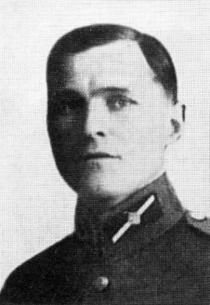

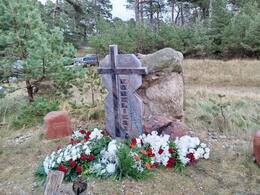
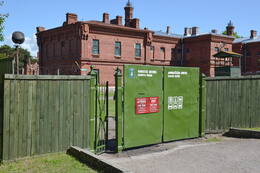
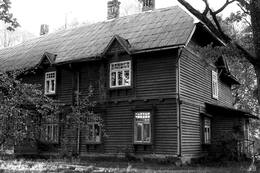
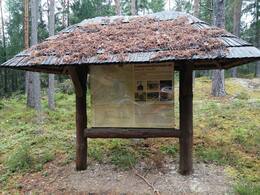
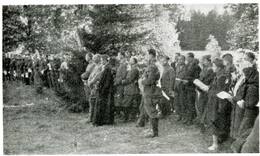
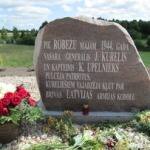


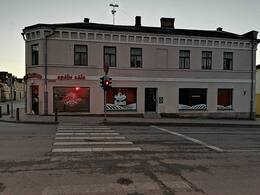
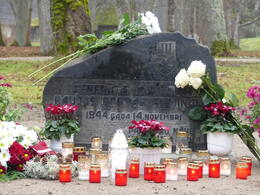
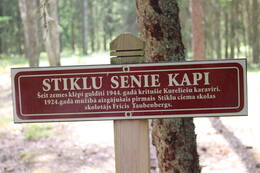

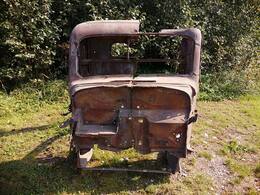
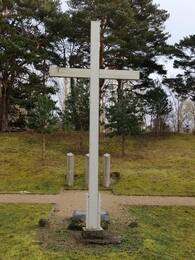
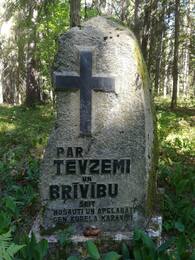
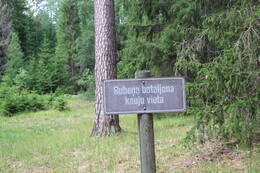
Part of this is a myth. I am Eduards granddaughter from his second marriage. His first wife had two daughters and a son who died in a German tank division, he was about 17 years old at the time. There is no way his first wife could have heard about the military court, let alone attended or delivered a letter, as she was in Poland. The "court-martial" (which was obviously illegal as the Kurelieshi were not part of the German Army) was an ambush. He was arrested at a 'meeting' and tried and condemned the next day. We have letters he wrote from prison before and after the 'trial'. He had 3 children with his second wife who was near Talsi during the trial, followed to Stutthof but was unable to contact him there. She migrated to Australia. His first wife's family migrated to America. We don't know why he wasn't shot at the trial, but there was no letter.